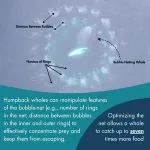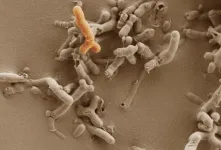(Press-News.org) How do bad bacteria find entry points in the body to cause infection?
This question is fundamental for infectious disease experts and people who study bacteria. Harmful pathogens, like Salmonella, find their way through a complex gut system where they are vastly outnumbered by good microbes and immune cells. Still, the pathogens navigate to find vulnerable entry points in the gut that would allow them to invade and infect the body.
A team of UC Davis Health researchers has discovered a novel bioelectrical mechanism these pathogens use to find these openings. Their study was published today in Nature Microbiology.
Bacteria breaking through the gated gut
Salmonella cause about 1.35 million illnesses and 420 deaths in the United States every year. To infect someone, this pathogen needs to cross the gut lining border.
“When ingested, Salmonella find their way to the intestines. There, they are vastly outnumbered by over 100 trillion good bacteria (known as commensals). They are facing the odds of one in a million!” said the study’s lead author Yao-Hui Sun. Sun is a research scientist affiliated with the Departments of Internal Medicine, Ophthalmology and Vision Science, and Dermatology.
To learn how Salmonellae find their way in the intestine, the researchers observed the movement of S. Typhimurium bacteria (a strain of Salmonella) and compared it to that of a harmless strain of Escherichia coli (E. coli) bacteria.
Navigating a complex gut landscape
The intestine has a very complex landscape. Its epithelial structure includes villus epithelium and follicle-associated epithelium (FAE). Villus epithelium is made of absorptive cells (enterocytes) with protrusions that help with nutrient absorption.
FAE, on the other hand, contains M cells overlying small clusters of lymphatic tissue known as Peyer’s patches. These M cells are tasked with antigen sampling. They act as the immune system's first line of defense against microbial and dietary antigens.
Findings
The research that was done on a mouse model showed that Salmonellae detect electric signals in FAE. They move toward this part of the gut where they find openings through which they can enter. This process of cell movement in response to electric fields is called galvanotaxis, or electrotaxis.
“Our study found that this ‘entry point’ has electric fields that the Salmonella bacteria take advantage of to pass,” said the study’s senior author Min Zhao. Zhao is a UC Davis professor of ophthalmology and dermatology and a researcher affiliated with the Institute for Regenerative Cures.
The study also showed that E. coli and Salmonella respond differently to bioelectric fields. They have opposite responses to the same electric cue. While E. coli clustered next to the villi, Salmonella gathered to FAE.
The study detected electric currents that loop by entering the absorptive villi and exiting the FAE.
“Notably, the bioelectric field in the gut epithelia is configured in a way that Salmonellae take advantage of to be sorted to the FAE and less so for E. coli,” explained Sun. “The pathogen seems to prefer the FAE as a gateway to invade the host and cause infections.”
Previous studies have indicated that bacteria use chemotaxis to move around. With chemotaxis, the bacteria sense chemical gradients and move towards or away from specific compounds. But the new study suggests that the galvanotaxis of Salmonella to the FAE does not occur through chemotaxis pathways.
“Our study presents an alternative or a complementary mechanism in modulating Salmonella targeting to the gut epithelium,” Zhao said.
Potential link to IBD and other gut disorders
The study might have the potential to explain complex chronic diseases, such as inflammatory bowel disease (IBD).
“This mechanism represents a new pathogen-human body “arms race” with potential implications for other bacterial infections as well as prevention and treatment possibilities,” Zhao said. “It is believed that the root cause of IBD is an excessive and abnormal immune response against good bacteria. It will be interesting to learn whether patients prone to have IBD also have aberrant bioelectric activities in gut epithelia.”
UC Davis Health coauthors of the study are Fernando Ferreira, Brian Reid, Kan Zhu, Li Ma, Briana M. Young, and Renée M. Tsolis. Other coauthors are Catherine E. Hagan and Alex Mogilner.
END
Gut bioelectricity provides a path for bad bacteria to cause diseases
Study discovers an electric current in the gut that attracts pathogens like Salmonella
2024-08-21
ELSE PRESS RELEASES FROM THIS DATE:
RPI and Hokkaido University sign letter of intent for semiconductor collaboration
2024-08-21
Today, Rensselaer Polytechnic Institute and Hokkaido University of Japan announced their plan to explore collaborative opportunities in semiconductor education and research contributing to semiconductor workforce development initiatives.
The two universities recognized the new partnership with a letter of intent signing ceremony held in the Curtis R. Priem Experimental Media and Performing Arts Center, with representatives from the Hokkaido Prefecture government, the Japanese semiconductor company Rapidus, IBM, NY CREATES, and RPI faculty and students in attendance.
Before the signing ceremony, the Japanese delegation toured the IBM Quantum System One ...
Just 1-2 cigarettes/day before or during pregnancy linked to major newborn health problems
2024-08-21
Even light smoking of just 1-2 cigarettes a day either before or at any time during pregnancy is significantly associated with major health problems in the newborn, finds research published online in the Journal of Epidemiology & Community Health.
The findings add to the evidence indicating that women hoping to become, or who are, pregnant should stub out smoking to protect their newborn’s health, say the researchers.
Deaths and serious health issues among newborns have fallen sharply, largely due to improvements in maternity care. But admission ...
Social position linked to food delivery preferences in England
2024-08-21
Social position—defined by household income and job role—is linked to food delivery preferences in England, suggests an analysis of consumer research published in the open access journal BMJ Public Health.
Affluent households are twice as likely as less well off ones to shop online for groceries while households in lower social grades are up to twice as likely to use food delivery apps for take-away meals. And users of these apps are more likely to be living with obesity, the findings indicate.
Digital on-demand ...
20 minutes of mindful breathing can rapidly reduce intensity of cancer pain
2024-08-21
Twenty minutes of mindful breathing, which focuses a person’s attention on their breath, can rapidly reduce the intensity and unpleasantness of cancer pain and relieve the associated anxiety, suggest the findings of a small comparative study, published online in the journal BMJ Supportive & Palliative Care.
Mindful breathing complements traditional pain relief and broadens the repertoire of options available for cancer patients, say the researchers.
Moderate to severe pain affects an estimated 30-40% of patients with cancer worldwide, as a result of the tumour compressing or ...
Hospital bacteria tracked better than ever before with new technique
2024-08-21
Researchers have developed a new genomic technique that can track the spread of multiple superbugs in a hospital simultaneously, which could help prevent and manage common hospital infections quicker and more effectively than ever before.
The proof-of-concept study, from the Wellcome Sanger Institute, the University of Oslo, Fondazione IRCCS Policlinico San Matteo in Italy, and collaborators, details a new deep sequencing approach that captures all the common infectious bacteria in a hospital at once. Current methods culture and sequence all pathogens separately which takes longer and requires more work.
Published ...
Red and processed meat consumption associated with higher type 2 diabetes risk, study of two million people finds
2024-08-21
Meat consumption, particularly consumption of processed meat and unprocessed red meat, is associated with a higher type 2 diabetes risk, an analysis of data from 1.97 million participants, published today in The Lancet Diabetes and Endocrinology, has found.
Global meat production has increased rapidly in recent decades and meat consumption exceeds dietary guidelines in many countries. Earlier research indicated that higher intakes of processed meat and unprocessed red meat are associated with an elevated risk of type 2 diabetes, but the results have been variable and not conclusive.
Poultry ...
Environmental laws failing to slow deforestation
2024-08-21
Australia’s environmental laws are failing to stop high rates of tree clearing to make way for agriculture, development and mining, according to University of Queensland research.
PhD candidate Hannah Thomas from UQ’s School of the Environment led a team which used satellite mapping and land clearing data to analyse vegetation loss across northern Australia, including Queensland, the Northern Territory and Western Australia.
“We mapped clearing greater than 20 hectares and then investigated which national or state and territory laws were likely to apply,” Ms Thomas said.
“Of the 1.5 million hectares ...
Mother’s gut microbiome during pregnancy shapes baby’s brain development
2024-08-21
A study in mice has found that the bacteria Bifidobacterium breve in the mother’s gut during pregnancy supports healthy brain development in the fetus.
Researchers have compared the development of the fetal brain in mice whose mothers had no bacteria in their gut, to those whose mothers were given Bifidobacterium breve orally during pregnancy, but had no other bacteria in their gut.
Nutrient transport to the brain increased in fetuses of mothers given Bifidobacterium breve, and beneficial changes were also seen in other cell processes relating to growth.
Bifidobacterium breve is a ‘good bacteria’ that occurs naturally in our ...
Humpbacks are among animals who manufacture and wield tools
2024-08-21
In a study published today in Royal Society Open Science, researchers at the Marine Mammal Research Program (MMRP) at UH Hawaiʻi Institute of Marine Biology (HIMB) and Alaska Whale Foundation (AWF) consider a new designation of the humpback whales they study: tool wielders. Researchers have known that humpback whales create “bubble-nets” to hunt, but they have learned that the animals don’t just create the bubble-nets; they manipulate this unique tool in a variety of ways to maximize their food intake in Alaskan feeding grounds. This novel research demystifies a behavior key to the whales’ survival and offers a compelling case for including humpbacks among the rare ...
UTA federal research expenditures doubled in 2023
2024-08-20
In 2023, federally sponsored research at The University of Texas at Arlington accounted for $77 million in expenditures, with about $40.7 million spent on research-related goods and services in Texas. That more than doubles the total for 2022, when federally sponsored research at UTA contributed $38 million to the economy.
The $77 million is a portion of UTA’s $122 million in total research expenditures from all sources last year. This number includes federally sponsored research awards as well as those from local and state governments, private institutions, and other sources. Overall, UT Arlington and its 270,000 alumni contribute $29 billion ...
LAST 30 PRESS RELEASES:
Why nail-biting, procrastination and other self-sabotaging behaviors are rooted in survival instincts
Regional variations in mechanical properties of porcine leptomeninges
Artificial empathy in therapy and healthcare: advancements in interpersonal interaction technologies
Why some brains switch gears more efficiently than others
UVA’s Jundong Li wins ICDM’S 2025 Tao Li Award for data mining, machine learning
UVA’s low-power, high-performance computer power player Mircea Stan earns National Academy of Inventors fellowship
Not playing by the rules: USU researcher explores filamentous algae dynamics in rivers
Do our body clocks influence our risk of dementia?
Anthropologists offer new evidence of bipedalism in long-debated fossil discovery
Safer receipt paper from wood
Dosage-sensitive genes suggest no whole-genome duplications in ancestral angiosperm
First ancient human herpesvirus genomes document their deep history with humans
Why Some Bacteria Survive Antibiotics and How to Stop Them - New study reveals that bacteria can survive antibiotic treatment through two fundamentally different “shutdown modes”
UCLA study links scar healing to dangerous placenta condition
CHANGE-seq-BE finds off-target changes in the genome from base editors
The Journal of Nuclear Medicine Ahead-of-Print Tip Sheet: January 2, 2026
Delayed or absent first dose of measles, mumps, and rubella vaccination
Trends in US preterm birth rates by household income and race and ethnicity
Study identifies potential biomarker linked to progression and brain inflammation in multiple sclerosis
Many mothers in Norway do not show up for postnatal check-ups
Researchers want to find out why quick clay is so unstable
Superradiant spins show teamwork at the quantum scale
Cleveland Clinic Research links tumor bacteria to immunotherapy resistance in head and neck cancer
First Editorial of 2026: Resisting AI slop
Joint ground- and space-based observations reveal Saturn-mass rogue planet
Inheritable genetic variant offers protection against blood cancer risk and progression
Pigs settled Pacific islands alongside early human voyagers
A Coral reef’s daily pulse reshapes microbes in surrounding waters
EAST Tokamak experiments exceed plasma density limit, offering new approach to fusion ignition
Groundbreaking discovery reveals Africa’s oldest cremation pyre and complex ritual practices
[Press-News.org] Gut bioelectricity provides a path for bad bacteria to cause diseasesStudy discovers an electric current in the gut that attracts pathogens like Salmonella







